Adventist Youth Honors Answer Book/Recreation/Rock Climbing
< Adventist Youth Honors Answer Book < Recreation| Rock Climbing | ||
|---|---|---|
| Recreation General Conference See also Rock Climbing - Advanced |
Skill Level 2 |  |
| Year of Introduction: 1970 | ||
Rappel Master Certified Instructor Required.
3. Show how to care for and coil the climbing rope. Know how to tie and use the following knots: bowline on a coil, bowline on a bight, figure eight, ring bend, double fisherman's, and prussik.
Caring for and Coiling the Climbing Rope
Adventist Youth Honors Answer Book/Knot/Care Of Rope
Bowline on a coil
| Bowline on a coil |
|---|
 Use: This is used as an impromptu harness, however is not recommended today since there are commercially available pre-fabricated harnesses. This method is preferable to a single loop because it distributes weight across all the loops/wraps.
How to tie:
|
On step 3, the working end of the rope must go around both ends creating the loop. Otherwise the rope will slip. The video is incorrect.
Bowline on a bight
| Bowline on a bight |
|---|
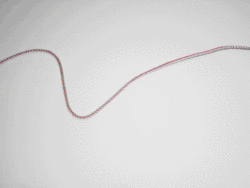 Use: This makes a secure loop in the middle of a rope which does not slip.
How to tie:
|
Figure Eight
| Figure Eight |
|---|
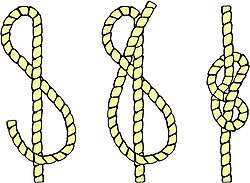 Use: This knot is ideal for keeping the end of a rope from running out of tackle or pulley.
How to tie:
|
Ring Bend
| Ring Bend (Water Knot, Tape Knot) |
|---|
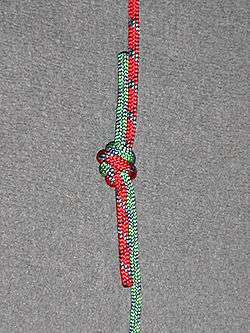 Use: The water knot (or tape knot) is a knot frequently used in climbing for joining two ends of webbing together, for instance when making a sling.
The ends should be left at least three inches long and the knot should be "set" by tightening it with full body weight. The ends can be taped or lightly sewn to the standing parts to help prevent them from creeping back into the knot. Inspect the knot before each use.
How to tie:
|
Double Fisherman's
| Double Fisherman's Knot |
|---|
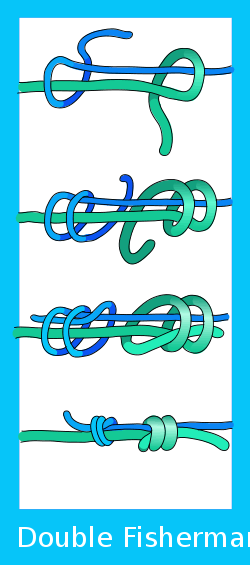 Use: Joining thin, stiff or slippery lines, backing up critical knots such as the Figure-of-eight loop or Figure-of-eight follow through.
Use the double fisherman's knot to tie together two ropes of unequal sizes. This knot and the triple fisherman's knot are the variations used most often in rock climbing, but other uses include search and rescue. The primary use of this knot in rock climbing is to form high strength loops of cord for connecting pieces of the rock climber's protection system. It is favoured for being compact, and for arranging the line of force in a straight line through the knot. Another common use for this knot is to back up a critical knot, such as a harness tie-in knot or single-line rappel rigs. In this use, the running end is tied around the standing end of the rope, so that it cannot slip back through the knot.How to tie:
|
Prussik
| Prusik knot |
|---|
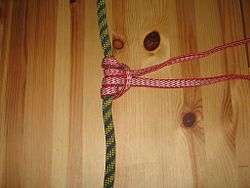 Use: A Prusik (aka Prussik or Prussic) is a friction hitch used in climbing, canyoneering, caving, rope rescue and by arborists to grab a rope (sometimes referred to as a rope-grab). The term Prusik is used both for the knot, for the loops of cord, and for the action (to prusik).
A Prusik rope is a circular loop with a circumference of 20 to 100 cm Prusiks will work around two ropes, even two ropes of different diameters. Prusiks provide a high-strength and relatively fail-safe (i.e., they will slip before damaging the rope or breaking) attachment, and are used in some rope-rescue techniques. Prusiks are good to use in hauling systems where multiple rope-grabs may be needed, and where mechanical rope-grabs are not available. Although the Prusik Climb technique may be called old-school by some, the US Army still includes it in its annual Best Ranger competition. Rangers in the competition routinely make it up a 90 foot rope in under a minute.How to tie:
|
10. Show how to set up a rappel. Rappel using figure eights or other mechanical brake methods. Do at least two 50-foot (15.24 meters) rappels.
Figure eight
Sometimes just called "eight", this device is most commonly used as a descender, but may also be used as a belay device in the absence of more appropriate equipment.
It is an aluminium (or occasionally steel) "8" shaped device, but comes in several varieties. Its main advantage is efficient heat dissipation. A square eight, used in rescue applications, is better for rappelling than the traditional 8. Because of the "ears" or "wings" on the rescue 8, there is less chance of forming a girth hitch while rappelling very quickly.
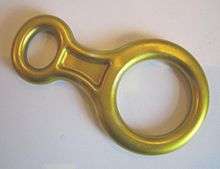
Figure eights allow fast but controlled descent on a rope. They are easy to set up and are effective in dissipating the heat caused by friction but have a tendency to put a twist in the rope. This twisting only occurs during improper use of the 8. Holding the brake hand off to the side twists the rope, whereas holding the brake hand straight down, parallel to the body, allows a controlled descent without twisting the rope. Because of the many bends it puts into the rope, an 8 descender can wear a rope quicker than a tube style belay/rappel device. Many sport climbers also avoid them because of the extra bulk an 8 puts on the rack. However, many ice climbers prefer to use the 8, because it is much easier to thread with stiff or frozen rope.
Rescue eight
A rescue eight is a variation of a figure eight, with "ears" or "wings" which prevent the rope from "locking up" or creating a girth hitch, thus stranding the rappeller on the rope. Rescue eights are frequently made of steel, rather than aluminum.




